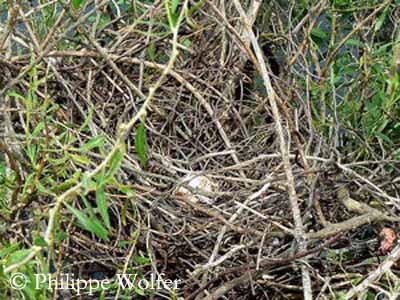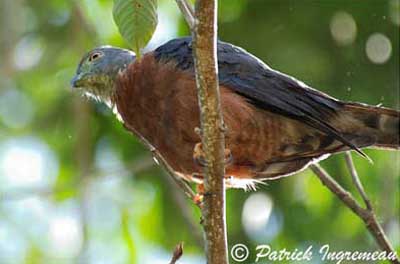
Cuckoo-hawks, Kites, Honey-buzzards
Third subgroup
1 - New World Kites
The third subgroup includes several species which have another physical difference. All have the basal joint of the middle toe fused with the next joint beyond it.
We find here eight genera, four from the New World (Rosthramus, Helicolestes, Harpagus and Ictinia), two from the Old World (Milvus and Haliastur) and two from Australia (Lophoictinia and Hamirostra).
The first genera Rosthramus and Helicolestes include two species, the Snail Kite (Rosthramus sociabilis) and the Slender-billed Kite (Helicolestes hamatus). Both have slender, strongly curved bill, adapted to their feeding behaviour. They have slate-grey plumage overall, but the Snail Kite has white patch at tail base, white terminal band and red-orange eyes, whereas the Slender-billed Kite is darker and lacks the white parts, and has yellow eyes.
Texte de Nicole Bouglouan
Photographes:
Marc Chrétien
MURINUS
Steve Garvie
RAINBIRDER Photo galleries
Tom Grey
Tom Grey's Bird Pictures
Patrick Ingremeau
TAMANDUA
Philippe et Aline Wolfer
GALERIE
Sources:
HANDBOOK OF THE BIRDS OF THE WORLD Vol 2 by Josep del Hoyo-Andrew Elliot-Jordi Sargatal - Lynx Edicions - ISBN: 8487334156
L’ENCYCLOPEDIE MONDIALE DES OISEAUX - Dr Christopher M. Perrins - BORDAS - ISBN: 2040185607

Rosthramus sociabilis
They frequent flooded areas, marshes and stagnant lagoons which provide them their preferred food, the aquatic apple snails of genus Pomacea. They can take other snails’ species, but also different preys during droughts such as turtles, crabs and rodents.
They hunt from a low perch and snatch the snails from shallow water with the feet. Then, they return to the perch to extract the snail from the shell thanks to the hooked bill.


Snail Kite - Rosthramus sociabilis
They build a stick nest in tree. Two or three eggs are laid and incubation lasts between 26 and 30 days. The young fledge at 35 days in Slender-billed Kite, and between 40 and 49 days in Snail Kite. Both sexes share all the nesting duties.

The movements of these raptors are not well documented. The Snail Kite’s southernmost populations could migrate. But nomadic and dispersive movements are observed according to the drought and food resources.

Rosthramus sociabilis
The Slender-billed Kite is vulnerable to deforestation, and the Snail Kite is vulnerable to pesticides, drainage and degradation of wetlands. However, both species are not currently threatened.
The second genus Harpagus includes two species, the Double-toothed Kite (Harpagus bidentatus) and the Rufous-thighed Kite (Harpagus diodon). They have peculiar trait, with double “tooth” or two notches in the upper mandible. Both resemble more an Accipiter than other kites.



They have dark grey upperparts and barred tail. The Rufous-thighed Kite has white throat with dark central streak, greyish breast and belly and white undertail-coverts, and of course rufous thighs.
The Double-toothed Kite also has white throat with dark central streak, but breast and belly are rufous, with grey and white barring on lower belly, and white undertail-coverts. In both species, the bill is blackish with green-yellow cere, eyes are red or orange, legs and feet are yellow to orange.
Harpagus bidentatus

They frequent the rain forest but the Rufous-thighed Kite is found only in primary and more open forests than the Double-toothed Kite which occurs in second growth and disturbed forests. They soar over the woodlands but hunt under the canopy.
They feed on insects and small vertebrates, lizards, frogs and cicadas. The Double-toothed Kite catches the preys flushed by monkeys, and it follows them, perching from 30 metres away to the troop. The Rufous-thighed Kite may frighten small birds as an Accipiter, and follows army ant swarms.
Harpagus bidentatus
The shallow nest is made with twigs and placed in tree, higher in Double-toothed Kite (7-33 metres above the ground). Probably two eggs are laid but the nesting behaviour is poorly known.

They are presumably sedentary, with no movements known.
Both are threatened by deforestation, but can be seen in suitable habitat, although they are uncommon.
Then, we can find the genus Ictinia with two species, the Mississippi Kite (Ictinia mississippiensis) and the Plumbeous kite (Ictinia plumbea).
The Mississippi Kite is more similar to falcon than kite. It has pale grey body with blackish wings and tail.
The Plumbeous kite is darker, with grey upperparts and darker wings and tail. We can see a chestnut wing patch conspicuous in flight. Underparts are grey.
They have blackish bill, red eyes and yellow to orange-red legs and feet.

Ictinia plumbea
They frequent lowlands along forest edges or gallery forests, but the Mississippi Kite can be found in cultivated areas and even towns. It feeds mainly in grassland, savannahs and woodland edges. The Plumbeous kite occurs in primary forest near rivers, and also at high elevations according to the range.

Both feed primarily on insects such as cicadas, grasshoppers, dragonflies and beetles. The Mississippi Kite also takes small vertebrates, amphibians, reptiles, rodents and bats, and hunts easily on the wing. The Plumbeous kite takes some snails and snakes in addition to its insectivorous diet and hunts from perch or also on the wing, and often in flocks.
Ictinia plumbea
They nest in trees, in stick nest, flimsy and lined with green vegetation in Mississippi Kite, and bulky, high in tree over water in Plumbeous kite. Usually two eggs are laid, and incubation lasts about one month. The young are fed by both parents and fledge one month later.

Both species are migratory. The Mississippi Kite is a long-distance migrant which breeds from Arizona to Florida and winters in N Argentina and Paraguay. The Plumbeous kite is migratory only in N and S of its South American range but its movements are poorly known.
They have fairly stable populations and are not globally threatened.
Ictinia plumbea
The three genera of the New World are found mainly in northern half part of South America and Central America.